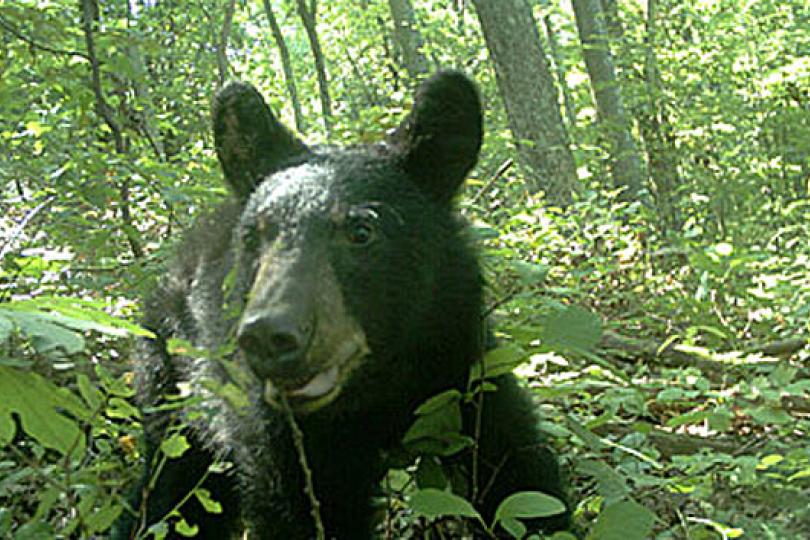'Camera Traps' Document Large Mammal Activity
Technology is often accused of separating us from nature. 2011 Fellow Tavis Forrester’s eMammal project puts high-tech “camera traps” into the hands of volunteer citizen scientists, allowing them to connect with animals and behaviors usually hidden from view. The result is a blending of technology and nature that Forrester says is “magical in its ability to fire up kids and adults alike" with the excitement of scientific discovery.
Camera traps are high-speed cameras that shoot digital images whenever they sense motion or a heat source in front of them. They allow scientists to observe animals in a detailed way that is usually only possible with hundreds, if not thousands, of hours of painstaking documentary work by film crews working in the wild.
eMammal is a large-scale NSF-funded citizen science project of the Smithsonian Conservation Biology Institute to train volunteers in the placement of and collection of images from these camera traps. The eMammal infrastructure allows citizen scientists to do camera trapping at a landscape scale, capturing images over a broader area than would be possible by scientists working alone. Although initial training is a bit harder than with other citizen science projects, because the volunteers have to be trained to place the cameras correctly, every observation is documented by an image, making the science foolproof once a camera is placed correctly.
The initial in-person training conducted by Forrester and his team is six hours long, but he says 97% of the cameras new trainees put out are deemed acceptable for scientific purposes on the first attempt. The images collected are comparable to those captured by trained scientists, making the program hugely successful. Forrester is working to put the training materials online in an interactive format that combines tutorial videos and comprehension quizzes, which has the potential to expand the reach of the program quickly.
Forrester says the enthusiasm generated by a discovery pulls people in. Interest in the program has spread through word-of-mouth, and the program has generated a lot of excitement among teachers, who can build camera trapping into their science curricula.
Although the initial investment in camera traps is higher than in other citizen science projects, and the traps require training to learn how to place and operate them, Forrester says they get people excited about the outdoors in a powerful way.
“Camera trapping is a little bit like a treasure hunt,” says Forrester. “You get to take the memory card out and see the photos. It fires up kids and adults with the wonder of the discovery. The imagery is really the unique, magical thing about camera traps, because you are getting to see something you usually don’t get to see."
For example, a family living next to the Catoctin Mountain Park in Maryland placed a camera trap on a trail they often hiked during the day. Some of their first camera images were of bobcats using the trail at night after park visitors had gone home. “It was like a whole new world opened up to them in this place that they love," says Forrester.
The images from the eMammal project are already being used to give park managers from Maryland to South Carolina and Tennessee critical information about what species they have in their parks and the relative abundance of each. The collected data will be stored in a database at the Smithsonian Institute and shared worldwide through a partnership with the Wildlife Conservation Society.
In the future, Forrester anticipates the creation of a camera trapping federation, which would help standardize how data is collected and structured to allow researchers from around the world to share their data. eMammal will be one of the online repositories for sharing data, with other NGOs, scientists and conservationists from abroad all contributing. In the meantime, eMammal will be expanded beyond the mid-Atlantic states to the continental United States. Eventually, it will be in use internationally.
The data is already being used by Forrester and his team to look at the effects of development around parks on the diversity and behavior of animals inside the parks. He says they are working on analyzing how human uses, like hunting and hiking, affect what animals are present and how they behave. They are using that work to launch their next grant, which looks at how predators are moving back into settled areas.
Forrester is currently working on a three-year postdoc with eMammal, and he says this work combines his passion for wildlife ecology with his interest in environmental education. He trained as a wildlife tracker, which trains individuals to recognize signs of animal activity to collect and confirm data similar to that being collected by the camera traps. Camera traps are an easier and potentially more accurate way to collect the same information and involve citizen scientists in the research.
He says one of the greatest benefits of eMammal is that it gets hard data into the public sphere much faster than traditional research methods, allowing conservation decisions to be based on current information instead of forcing land managers to wait for scientific publications.
He also enjoys getting people excited about nature and likes that eMammal "short circuits the narrative that technology and nature are in opposition.”
“Being in the woods with a purpose is very different from recreating in nature,” says Forrester. “You pay attention to animal sign and where animals are moving. You have to understand how the sun is moving to maximize the clarity and usefulness of the photos. And you get the experience of being out there in a focused way. That is an incredible experience that is very different from how we normally experience nature nowadays.”
The potential of camera trapping and other citizen science projects to democratize science is particularly inspiring for Forrester. He acknowledges that some science is complicated and will always be specialized, but he says that learning how to ask the right questions and collect the right information to answer them is a valuable skill for everyone. More importantly, he says, volunteers often have incredible ideas for projects based on their understanding and knowledge of the local area. Citizen science has the power to engage people in solving real problems and, Forrester says, that is critical because “part of civic society is being engaged with science.”

